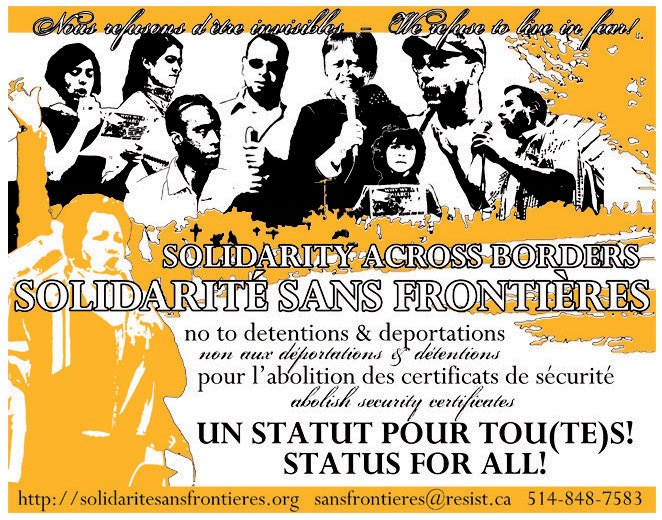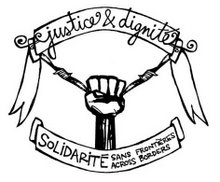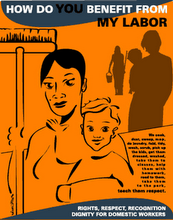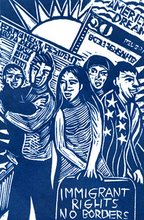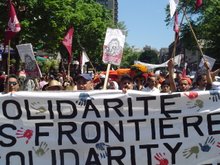http://www.dominionpaper.ca/articles/960
Gaining Ground
"A monumental year" for the people of Six Nations
by Hillary Bain Lindsay
On January 1, 2007, the people of Six Nations arrived at their Council House, and walked inside.
The event did not make media headlines, but the significance of the day was not lost on those crowded into the long line of cars, bearing Iroquois Confederacy and Unity flags, that lead up to the Council House.
“Even before Canada declared itself a country, we had a meeting place down here for traditional governance,” says Janie Jamison, one of the spokespeople for Six Nations. For generations, Chiefs representing the Confederacy Council gathered in the Council House to make decisions by consensus, a process often called the oldest participatory democracy on Earth.
In 1924, however, Canada instated the Indian Act and the RCMP raided the Council House, removing the traditional chiefs and clan mothers. In its place the band council system was set up, acting as an arm of the Canadian government.
For Jamison, who has never seen herself as Canadian, destroying the traditional government and imposing a new one was Canada’s way of declaring that her culture, her nation, her people “no longer existed.”
“What people don’t understand is that we weren’t defeated at that point,” says Jamison. “Our traditional government went underground.” For decades it continued to operate, unrecognized by the federal government. In 1959 an attempt was made to take back the Council House, remove the band council and reinstate the traditional governance system. The RCMP moved in again. “Men, women and children were beaten,” says Jamison. “Our people weren’t successful then.”
But on New Year’s Day, “Eighty years after being told we don’t exist,” says Jamison, “here we are.”
The people of Six Nations made their existence difficult to ignore starting February 28, 2006, when a blockade set up near Caledonia, Ontario, halted the construction of a subdivision that many said was being built on unceded Six Nations’ territory. Almost a year later, the people of Six Nations are holding their ground and, according to spokesperson Hazel Hill, making “leaps and bounds” towards the reinstatement of their traditional government.
The first leap came shortly after April 20, 2006, when the Ontario Provincial Police (OPP) performed a pre-dawn raid on the blockade site. The raid, meant to clear the site of protesters, backfired when hundreds of Six Nations’ people and their supporters peacefully took back the site within a few hours. The resolve and determination of those holding the site was strengthened, and media coverage of the raid ensured that people across the country and around the world knew about the standoff.
Shortly after the police raid, the Six Nations’ band council, which had previously refused to support the blockade (though it did support the land claim), endorsed the leadership of the Confederacy Chiefs.
The move was significant. “Eighty to eighty-five per cent of [Six Nations] people support the traditional government,” says Hill. For the first time, the leadership that had always been recognized by the people of Six Nations would be the leadership that government would be forced to negotiate with.
Another leap came when – after months of calling the standoff a provincial matter – the federal government came to the table. “It’s the first time the federal government has sat down with the traditional government,” Barbara MacDougal, Canada’s representative at negotiations, told the CBC in September 2006, adding that it was a “tremendous breakthrough.”
The breakthrough may have been spurred on by Six Nations representative Doreen Silversmith when she spoke to the United Nations’ Permanent Forum on Indigenous People in Geneva, Switzerland, on May 1, 2006. Referring to the raid, Silversmith said, “Canada has clearly portrayed the message that ‘might is right.’ When a situation of ownership is challenged, their laws allow them to continue to reap the benefits of our Land, destroy our environment, and clearly ignore the truth of the Onkwehonweh [First People] … who hold title to the Land.” At the end of her speech, she called on the international community to intervene at Six Nations. “The Onkwehonweh require your assistance, with respect to our Law, our Treaties, including the Two Row Wampum, and in effect, the Authority with respect to our Land, Our Law and Our People.”
“To have the confederacy recognized at the international level for the traditional government that they are, that they always were, and always will be,” was important says Jamison. She feels that recognition from the United Nations forced Canadians to appreciate the legitimacy of their struggle. “We aren’t making these things up,” she says. “We are a government of people, a nation of sovereignty.” This, she says, is something Canada is going to have to deal with.
Jamison has been living with the legacy of Canada’s denial for too long, she says. “My family has had too many things stolen from them.” And she’s not just talking about land. “When I was three years old, I was home alone with my mom and she shot herself–. She was a victim of residential school system,” says Jamison. Her aunt was one of the thousands of native women in Canada who have gone missing; her raped and brutalized body found later. Jamison’s sister was put in an orphanage at birth and remained there until she was two. “She could have ended up on a pig farm like so many others, but somehow she made it back to us,” she says. And finally, a year and a half ago, her 17-year-old son crashed his car while he was driving drunk. “We watched him die a slow death after his car rolled. He died last April.”
Her family isn’t just the victim of bad luck, says Jamison, but of deliberate government policies that have driven so many of her people to despair and death. “That’s why I made that decision to take that stand. No more. No more to make us become something that we never will be” she says. “We need to learn truth, acceptance and understanding to be able to coexist together.”
For Jamison, that starts with “Canada finally taking responsibility for what they’ve done and starting to pay back some of the money they owe our people.” These are “not handouts” emphasizes Jamison, but payments that are owed to the Six Nations from lease agreements that were never honoured. In terms of the piece of land at the heart of the dispute today: it’s not for sale.
“We’ve always said we’re not selling that land,” says Jamison.
This doesn’t mean that those living on the land now will have to move says Hill – though she notes that her people have been forced to relocate many times in their history. “But we’re not going to do it to them,” says Hill. “There’s a lot of that land that’s undeveloped, unceded. There’s a mechanism for returning that.”
“To me, it’s about continuing what we’ve started,” she says. “This isn’t just about Six Nations or that little piece of land. This is about sovereignty and the unity of the Original People of the land that have a right to live in harmony. To have clean air and green grass where you don’t have to live with landfills and concrete everywhere you look.”
We need homes, says Hill, “but not concrete jungles. There’s a difference.”
Gaining Ground
"A monumental year" for the people of Six Nations
by Hillary Bain Lindsay
On January 1, 2007, the people of Six Nations arrived at their Council House, and walked inside.
The event did not make media headlines, but the significance of the day was not lost on those crowded into the long line of cars, bearing Iroquois Confederacy and Unity flags, that lead up to the Council House.
“Even before Canada declared itself a country, we had a meeting place down here for traditional governance,” says Janie Jamison, one of the spokespeople for Six Nations. For generations, Chiefs representing the Confederacy Council gathered in the Council House to make decisions by consensus, a process often called the oldest participatory democracy on Earth.
In 1924, however, Canada instated the Indian Act and the RCMP raided the Council House, removing the traditional chiefs and clan mothers. In its place the band council system was set up, acting as an arm of the Canadian government.
For Jamison, who has never seen herself as Canadian, destroying the traditional government and imposing a new one was Canada’s way of declaring that her culture, her nation, her people “no longer existed.”
“What people don’t understand is that we weren’t defeated at that point,” says Jamison. “Our traditional government went underground.” For decades it continued to operate, unrecognized by the federal government. In 1959 an attempt was made to take back the Council House, remove the band council and reinstate the traditional governance system. The RCMP moved in again. “Men, women and children were beaten,” says Jamison. “Our people weren’t successful then.”
But on New Year’s Day, “Eighty years after being told we don’t exist,” says Jamison, “here we are.”
The people of Six Nations made their existence difficult to ignore starting February 28, 2006, when a blockade set up near Caledonia, Ontario, halted the construction of a subdivision that many said was being built on unceded Six Nations’ territory. Almost a year later, the people of Six Nations are holding their ground and, according to spokesperson Hazel Hill, making “leaps and bounds” towards the reinstatement of their traditional government.
The first leap came shortly after April 20, 2006, when the Ontario Provincial Police (OPP) performed a pre-dawn raid on the blockade site. The raid, meant to clear the site of protesters, backfired when hundreds of Six Nations’ people and their supporters peacefully took back the site within a few hours. The resolve and determination of those holding the site was strengthened, and media coverage of the raid ensured that people across the country and around the world knew about the standoff.
Shortly after the police raid, the Six Nations’ band council, which had previously refused to support the blockade (though it did support the land claim), endorsed the leadership of the Confederacy Chiefs.
The move was significant. “Eighty to eighty-five per cent of [Six Nations] people support the traditional government,” says Hill. For the first time, the leadership that had always been recognized by the people of Six Nations would be the leadership that government would be forced to negotiate with.
Another leap came when – after months of calling the standoff a provincial matter – the federal government came to the table. “It’s the first time the federal government has sat down with the traditional government,” Barbara MacDougal, Canada’s representative at negotiations, told the CBC in September 2006, adding that it was a “tremendous breakthrough.”
The breakthrough may have been spurred on by Six Nations representative Doreen Silversmith when she spoke to the United Nations’ Permanent Forum on Indigenous People in Geneva, Switzerland, on May 1, 2006. Referring to the raid, Silversmith said, “Canada has clearly portrayed the message that ‘might is right.’ When a situation of ownership is challenged, their laws allow them to continue to reap the benefits of our Land, destroy our environment, and clearly ignore the truth of the Onkwehonweh [First People] … who hold title to the Land.” At the end of her speech, she called on the international community to intervene at Six Nations. “The Onkwehonweh require your assistance, with respect to our Law, our Treaties, including the Two Row Wampum, and in effect, the Authority with respect to our Land, Our Law and Our People.”
“To have the confederacy recognized at the international level for the traditional government that they are, that they always were, and always will be,” was important says Jamison. She feels that recognition from the United Nations forced Canadians to appreciate the legitimacy of their struggle. “We aren’t making these things up,” she says. “We are a government of people, a nation of sovereignty.” This, she says, is something Canada is going to have to deal with.
Jamison has been living with the legacy of Canada’s denial for too long, she says. “My family has had too many things stolen from them.” And she’s not just talking about land. “When I was three years old, I was home alone with my mom and she shot herself–. She was a victim of residential school system,” says Jamison. Her aunt was one of the thousands of native women in Canada who have gone missing; her raped and brutalized body found later. Jamison’s sister was put in an orphanage at birth and remained there until she was two. “She could have ended up on a pig farm like so many others, but somehow she made it back to us,” she says. And finally, a year and a half ago, her 17-year-old son crashed his car while he was driving drunk. “We watched him die a slow death after his car rolled. He died last April.”
Her family isn’t just the victim of bad luck, says Jamison, but of deliberate government policies that have driven so many of her people to despair and death. “That’s why I made that decision to take that stand. No more. No more to make us become something that we never will be” she says. “We need to learn truth, acceptance and understanding to be able to coexist together.”
For Jamison, that starts with “Canada finally taking responsibility for what they’ve done and starting to pay back some of the money they owe our people.” These are “not handouts” emphasizes Jamison, but payments that are owed to the Six Nations from lease agreements that were never honoured. In terms of the piece of land at the heart of the dispute today: it’s not for sale.
“We’ve always said we’re not selling that land,” says Jamison.
This doesn’t mean that those living on the land now will have to move says Hill – though she notes that her people have been forced to relocate many times in their history. “But we’re not going to do it to them,” says Hill. “There’s a lot of that land that’s undeveloped, unceded. There’s a mechanism for returning that.”
“To me, it’s about continuing what we’ve started,” she says. “This isn’t just about Six Nations or that little piece of land. This is about sovereignty and the unity of the Original People of the land that have a right to live in harmony. To have clean air and green grass where you don’t have to live with landfills and concrete everywhere you look.”
We need homes, says Hill, “but not concrete jungles. There’s a difference.”
